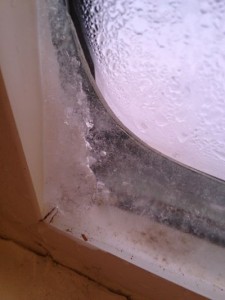Ice is always a problem in the winter. But window icing can be controlled. In fact it should be controlled.
The first thing you watch for is air movement by the windows. If you are blocking air movement at the windows with blinds or curtains, or if you are covering a heat register below the window, you need to fix this problem first. You may only need to raise the bottom of the blinds and inch or so to fix the problem. Usually you will need to do more than this.
If you still have ice on the windows your house is telling you that the humidity is too high relative to the temperature of the glass on your windows. The water vapor in the air has reached the dew point when it starts to condense on your windows. When the water vapor in the air gets cool enough, it will condense into fog and then as it cools further it turns to ice. This temperature is relative in that it will be different with different levels of humidity and air pressure.
You should watch your windows closely in the winter for signs of moisture. When you see water droplets or a light fog starting to accumulate on the bottoms of your windows your house is saying that you need to decrease the humidity. As far as I know that is the only factor over which you have control. I have tried, but so far have not found a way to raise the outside temperature or change the barometric pressure.
If you do not lower the humidity you will not only have condensation on the windows where you can see it, but you may be getting condensation in places you cannot see it, and that can cause mold. That is why you should not ignore window condensation. Think of condensation on your windows as an early warning sign, just like your smoke detector warns of fire, condensation can warn of mold.
There are two ways to decrease the humidity in your house. One is to exchange some of the humid interior air for the dry outside air. The other is to invest in a dehumidifier. I don’t have much experience with dehumidifiers and the little experience I do have has been disappointing so I will not go into this method at all.
Alaskan winter air is dry. Generally, the colder it gets in Alaska, the dryer is the air. You need to get some of that dry air into your house and let out some of the humid air. Many homes have an air exchange system that is controllable. You need to increase the air exchanges until the condensation goes away. This means that you should have a way to measure the humidity. You can buy a humidity meter at most department stores. You may have to bring the humidity below 20% which is uncomfortable for many people. Still, it’s better to deal with a little discomfort now than a lot of discomfort later.
If you don’t have an air exchange system, you can still take care of this problem by just barely opening a window on one side of the house and then turning on a kitchen fan or bathroom fan in the other side of the house. That will bring in the dry air and release the humid air. You will need to keep doing this until the humidity drops enough to stop the condensation on the windows. It’s a balancing act that you need to watch carefully.
Of course, this happens when it’s cold out, so people cringe at the thought of heating all that cold air. Who leaves their windows open in the middle of winter anyway? The answer is, people that don’t want mold growing in the deep dark corners of their house where they can’t see it, that’s who!




